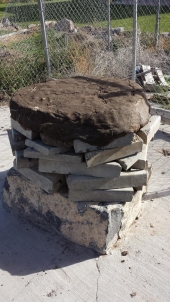We've got to keep this thread going! This topic is incredible and we need to keep sharing what we've learned.
I have a large yard and just finished my grass area. I also dug out the swimming area of my natural pool. Next spring I'll dig out the regeneration area and begin the long process of building it. here is what it looks like now.

The dimensions are about 40 x 50 for the swim area right now. I'll increase it another 10' on width and length in the spring. I also paid an electrician to put in an electrical outlet (240 W) close to where my pump will go.
I hope to get the rest of my questions answered about how to build this thing before the spring. It is a semi complicated thing to create and I want to do it right and ensure I have the right materials/amounts so my wife feels more comfortable with this idea. She's worried it'll just turn into an algae mosquito growing cesspool. Any help/ideas the team here can provide would be awesome.
Here are a few questions I have left.
-How clean does the water get if I use clay as the sealer?
-Can I by myself seal 2 or 3 pond liners together to create one large enough for my area?
-What are the best kinds of rock to use in the regeneration zone along with amounts?
-What kind of perforated pipe is used to draw water down through the gravel and how is that pipe connected to the pool pump?
Here are a few notes that I have made and what I have learned about making natural pools. Hope this is of some use.
Gravel
granite river rock, haydite(used by totalhabitat) or shingle
Amounts used by Genus- pool company- Plant Filter – 23 tons of granite river rock, 23 tons of granite peastone, 6 yards of sandy topsoil
This is part of your biofiltration system. Use only clean gravel for this process. Fill the bottom of the pool with four to five inches of gravel. Tumbled or manufactured gravel, or aggregates are fine for this purpose. This gives a place for beneficial bacteria to live as they help break down leaves and other things that your skimmer misses.
Perlite
Perlite is a volcanic rock that at high heating will change into very light, expanded glass stones.
It is similar to vermiculite but holds more air and less water.
Because it is so light, it can drifting away and is not suitable for active hydroponics where the water flows.
It is perfect for the sowing of plants that are destined to be grown on hydroponics.
Plants to use:
Bulrush (Scientific classification: Schoenoplectus lacustrine)
Papyrus (Scientific classification: Cyperus papyrus)
Yellow Iris (Scientific classification: Iris pseudacorus)
Swamp Lily (Scientific classification: Hedichium coronarium)
Junco (Scientific classification: Juncus sellovianus)
Cattails (Scientific classification: Typha spp)
D'water lettuce (Scientific classification: Pistia stratiotes)
Calamo Aromatic (Scientific classification: Acorus calamus)
Water hyacinth (Scientific classification: Eichornia crassipes)
Glass of Milk (Scientific classification: Zantedeschia aethiopica)
Biri (Scientific classification: Canna edulis)
Water lily (Scientific classification: Nymphaea spp)
Water hyacinth- good to clean out contaminants like metals,urine, other algae.
http://www.pondkoi.com/pond_plants_floating.htm - jumbo water hyacinth
water lilies
lotus
elodea- submerged plant that eats algae
pros/cons water plants and names of quite a few.
http://ohioline.osu.edu/a-fact/0017.html
(order plants from orem-
http://aquaticutah.com/viewtopic.php?f=14&t=1608)
JAPANESE TRAPDOOR ALGAE EATING POND SNAILS
http://www.pondplants1.com/snails.htm
http://www.thepondguy.com/product/algae-eating-black-japanese-trapdoor-pond-snails/
grass carp
Plecostomus fish- very good at cleaning algea. need to winter inside though.
SELECTING PLANTS Be sure to choose plants suited to your climate. Your best bet is to obtain your plants from a native-plant supplier. Check the phone book and Internet for local sources. Home and garden centers also carry more aquatic plants now that backyard ponds are growing in popularity. End-of-the-season sales can save you money. Several mail-order nurseries also specialize in water-garden plants. (See “Pool Construction and Design.”) Sedges (Carex) and rushes (Scirpus), both aquatic plants, make great emergent vegetation for your pool’s perimeter. You can also consider lesser cattails (Typha angustifolia) and aquatic irises, though be sure to ask which varieties won’t overcrowd other plants. Pickerel weed (Pontederia cordata), arrowhead (Sagittaria) and water primroses (Ludwigia) are all contenders for the shallowest areas of your pool. Be sure to include submergent plants such as common waterweed (Elodea) and hornwort (Ceratophyllum) for their high oxygen output. In water 6 to 18 inches deep, plant a mix of floating, submergent and emergent plants. Water lilies (Nymphaea) adapt to any depth, so use them liberally. Floaters, such as pondweeds (Potamogeton) and common duckweed (Lemna minor), drift freely on the surface and quickly cover the surface of the plant zone. Before you make plans to tromp off to the nearest country pond and gather up a truckload of greenery, wait! Before collecting a single plant from the wild, know the laws protecting wetlands and their plants. if you do collect, be careful to guarantee the health of the wetlancl by selecting only a few samples from larger populations. Consider rescuing plants from a threatened site. Perhaps a new corporate headquarter’s construction is going to destroy your favorite frog hollow. Contact the company to see if it will allow you to rescue the imperiled plants and maybe a few amphibians. Once you’ve purchased your plants, you can plant them in the filled pool. Stick to a plan, grouping plants according to height and type. Place your plants into the soil, anchoring them, with plenty of gravel.







